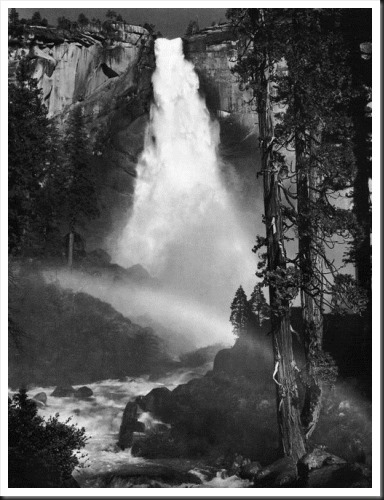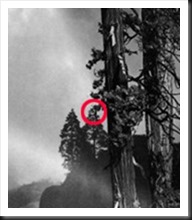There’s so much to learn from studying Ansel Adams’ photographs, especially when you read what he has to say about them in “Examples – The Making of 40 Photographs”. Each narrative seems to have its own distinct lesson. The narrative associated with Nevada Falls is a study in working a composition.
I often comment in my workshops that in composing an image you spend more effort on the edges than on the subject. Many photographers call it “Border Patrol.” This was certainly the case with this photograph.
“Because of the terrain and the complexity of the forest I was limited to one nearly ideal spot for my set-up. I had the time to engage in a protracted ballet with the tripod – forward, sideways, backward and raising and lowering….”
Adams was looking for the proper arrangement of the branches of the trees relative to the waterfall and the cliff. He found it difficult to get the trees on the left just right. And the whole process was complicated by the fact that he was working in a rock-strewn area. So moving his tripod with his 8×10 view camera attached was an arduous process. And all the time he and his gear were being drenched by the spray.
One of the things you can count on with Adams is the perfection of his compositions. However, he did point out one defect which he was unable to correct. Do you see it? It’s near the center just to the right. There are two cedar trees in the middle ground and the rightmost tree is behind a branch of a foreground tree. Lowering the camera by a foot would have fixed it but it was already as low as it could go.
My sense is that it took Adams hours to set up this shot. I think that is one of the lessons to be drawn from this – slow down. Adams had a clear idea of what he wanted – the rainbow in front of Nevada Falls at its fullest He knew enough of the physics of rainbows to anticipate where it would appear and worked out his composition in advance with this in mind. Also, he paid meticulous attention to minute details, moving his tripod (with great difficulty) to one by one resolve each of the problems, all but one. It takes time to first of all see the problems and then to work them out. The one remaining defect is instructive in that it clearly shows us the level of detail and perfection he demanded from his photographs.
But all of the problem solving that went into making this photograph (and composition was just one of the many problems he solved) would be meaningless if it did not do what Adams envisioned it would do – express the power of this magnificent waterfall in the strongest possible way. And the extraordinary talent and skill Adams brings to his photographs are subservient to this supreme goal – to share his vision and create a work of art that touches us all.
Join the conversation and leave a comment. We always enjoy hearing from you. Also feel free to Like this post and share it on Facebook, Twitter, Google+ and more. There is a link for that at the top.
Join me on an upcoming workshop. Click here for more details.
To see more of my photographs click here.
(2665)


